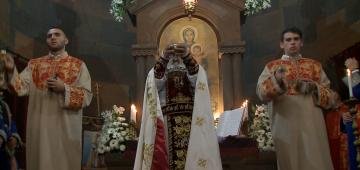 |
On this occasion of the Saint Gregory the Illuminator’s Commitment to the Pit the relic-bearing right hand of Gregory the Illuminator was taken to Khor VirapAccompanied by priests, the pilgrims went to the Khor Virap monastery to participate in the festive liturgy and commune with the relics of the saint. Khor Virap also commemorates the names of two disciples of Christ, Thaddeus and Bartholomew, who met in the area adjacent to Khor Virap while preaching the word of the Lord and erected a cross at that place as a sign of their meeting. |
 |
A church is being built in the village of Darbnik at the initiative of Bishop Gevorg SaroyanThe church will have an attached chapel, which will also serve as a candlelight hall, so that the ceremony is not disturbed during the liturgy. The church will have a Sunday school, a pastor's house and a library, that is, all conditions are created so that a full spiritual life can be organized. The village of Darbnik has more than 1,800 residents, who go to neighboring villages to participate in church services. |
 |
Arabkir YC will host relatives of their students for free for a monthThe Arabkir Youtth Center administration has given their students' mothers, grandmothers, and sisters the opportunity to attend any class for free for a month on Women's Day. In order to stay in touch with parents, almost all Youth Centers operate family clubs, sports grounds, and meetings are held. |
 |
Nork YC students returned with victories from the "Tbilisi Magical Spring" international competition-festival
Artistic groups from regional countries participated in the competition-festival. This was the first participation for the newly formed circus ensemble and the 5th grade of the dance school. The dance class presented an Armenian folk and modern dance performance at the competition and was awarded the "Best Choreography and Performance" award.
|
 |
The young people participated in the evening service at the Holy Mother of God Church in Lusagyugh
For the second year now, the youth unions of the Aragatsotn Diocese have been celebrating Great Lent by jointly participating in liturgies and services, after which they talk around the Lenten table. Young people have many questions, especially during Great Lent. There are 19 youth unions in the Diocese, which include about 350 young people and teenagers.
|
 |
The "Support Café for the Elderly of Artsakh" program is being implemented with AGBU funding
The program is implemented in Yerevan and Gyumri. The goal is to provide social support to forcibly displaced Artsakh seniors aged 60 and over. A professional team works with them for 12 weeks. In a group setting, through music, art therapy, and physical exercises, specialists try to improve the mental health of older Artsakh residents, increase self-confidence, and promote their socialization.
|
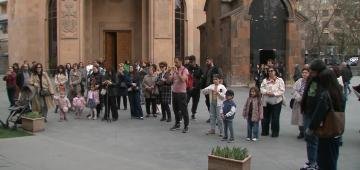 |
At the end of the Evening service, the faithful celebrated Median Day of Lent in the courtyard of St. Anna Church
The 48-day period of Lent is shared during the Median Day, which is a short retreat to reflect on the past and upcoming days of fasting, to review spiritual behavior, and to reflect on daily life. There are fewer church ceremonies during the Median Day, but instead there are many folk customs. In particular, after the evening service, people gather around the dinner table and share unleavened bread.
|
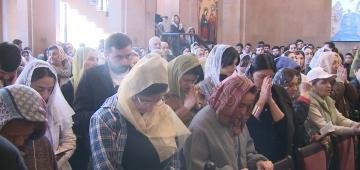 |
Lent provides an opportunity to focus on the course of life: Rev. Father Vahram Melikyan
Rev. Father Vahram Melikyan, believes that Lent has a special significance. It provides an opportunity for self-reflection and focusing on the course of one’s life. According to him, in addition to his daily contacts, a clergyman bears great responsibility before God and the people, and has many visitors who come to him with problems and pain. He believes that a clergyman also needs to go through all of this and be able to adopt the right internal positions to adopt postures.
|
 |
On International Down Syndrome Day, 6 singers and the "Shoghakat" choir presented a video clipThe NGO "Arev Children: Children's Health and Development Center" has been operating in Armenia since 2018. The center was established on the initiative of Father Grigor Grigoryan, and more than 220 children attend it. A large group of specialists work at the center, with group and individual involvement of children. From speech development to socialization, every small success has been preceded by years of consistent daily work. The center's specialists also work with the children's parents.
|
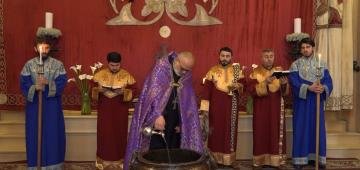 |
During Lent, a ceremony is performed in many churchesEvery Thursday evening during the Evening service at the Saint Anna and Catholicos of the Holy Mother of God churches in Yerevan, the ceremony of the Cross or the Cross-Bearing is also performed. With prayer and the singing of hymns dedicated to the cross, the priest blesses the water with the cross, asking the heavenly Lord for spiritual and physical healing for all who drink from it. During the ceremony, the Old Testament story of the prophet Elijah purifying polluted water and making it drinkable for people and animals is read. |
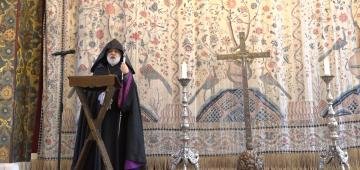 |
Great Lent began with Eve of Great Lent, which will end on the Feast of the Holy Resurrection
The Eve of Great Lent (Boon Barekendan) symbolizes the days that man lived in paradise. Great Lent begins the day after the feast and ends with the feast of the Holy Resurrection. These days symbolize the days Christ spent in fasting and repentance, when after his baptism he was tempted by the devil for 40 days in the desert.
|
 |
A matinee was organized at the writer's museum on the occasion of Ruben Sevak's 140th anniversaryThe entire archive of Ruben Sevak was collected by his nephew, Hovhannes Chilinkiryan. In 2013, through the efforts of the Patriarch of All Armenians, the MASE became the final resting place of Ruben Sevak. The museum tells its visitors about Ruben Sevak's literary and social activities; at the same time, it has also become a preferred place for organizing cultural events for many artists. Not only the writer's personal archive is presented, but also the works of Armenian artists of the same period. |
